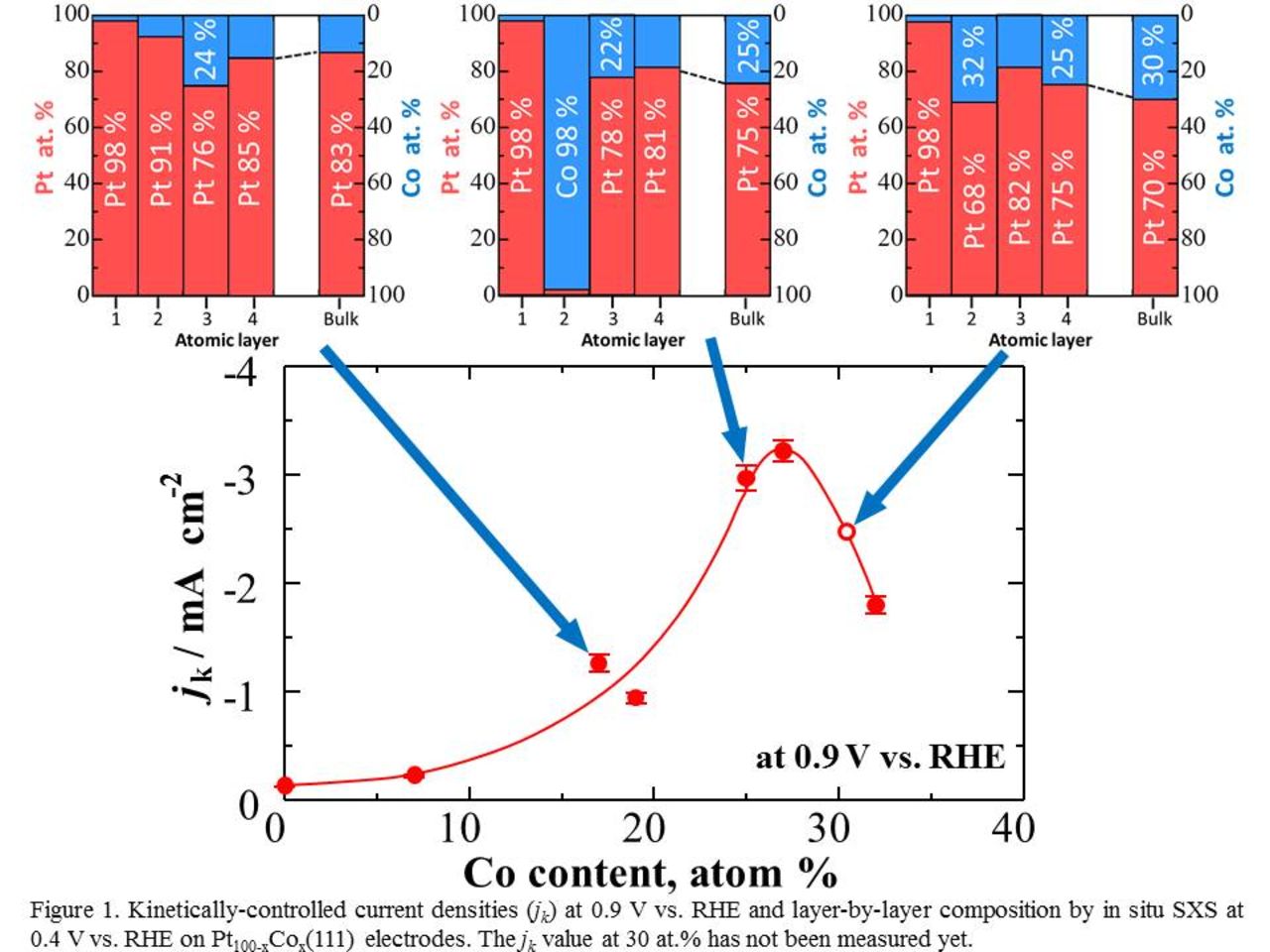Abstract
The R&D of highly active and durable cathode catalysts for the oxygen reduction reaction (ORR) is very important for polymer electrolyte fuel cells (PEFCs). Bimetallic alloys of Pt such as Pt-Co exhibit higher ORR activities than that of pure Pt.1 For polycrystalline Pt alloy electrodes, the kinetically-controlled area-specific current densities (jk) for the ORR strongly depend on the bulk Co composition.2 It is essential to analyze the mechanism of the increased ORR activity at well-defined Pt-alloys by multilateral techniques.
Recently, we have demonstrated the composition dependence of jk at a series of (111), (110), and (100) faces of Pt100−xCox single crystal electrodes, on which well-defined Pt-skin layers were formed by annealing in H2.3 The Pt-skin/Pt73Co27(111) electrode exhibited the highest jk value, which was about 27 times higher than that on pure Pt(111). In the present research, we have examined the effect of layer-by-layer composition, measured under electrochemical conditions, of three different Pt100−xCox(111) electrodes with varying Co bulk content (x = 17, 25, 30 at.%) on the ORR activity.
The Pt100−xCox(111) single crystal electrodes (ca. 3.5 mm in diameter and 1.5 mm in thickness) were prepared in the same manner as described in our previous work.3 The Co composition in bulk was evaluated by use of X-ray photoelectron spectroscopy (XPS). Prior to the all measurements, the Pt100−xCox(111) electrodes were heat-treated at 1170 K in 100% H2 to prepare the well-defined surface.
In-situ surface X-ray scattering (SXS) measurements were carried out at synchrotron radiation facilities (SPring-8 and the Photon Factory) in the same manner as described previously.4 After filling the electrochemical cell with N2-purged 0.1 M HClO4, the working electrode was polarized at 0.4 V vs. RHE. Structure parameters from the topmost to fourth layers were determined from the least-squares fitting to X-ray reflectivity data [(00) crystal truncation rod (CTR)] with a kinematical calculation based on a specific interfacial model.
Figure 1 shows the dependence of jk at 0.9 V vs. RHE on x, together with layer-by-layer composition of Pt and Co analyzed by in situ SXS. The composition of the topmost layer was found to be Pt 98 at.% for all three alloys, regardless of Co content, i.e., a Pt-skin layer was formed on the surface of the Pt-Co(111) single crystal electrodes. In contrast, the Co content in the second layer changed significantly with the Co content in bulk. It is striking that the second layer of Pt75Co25(111) (Pt3Co(111)) was nearly pure Co, 98 at.%, where the jk value was close to the maximum value, ca. 25 times higher than that of pure Pt(111). At Co 30 at.% in bulk, jk decreased, and the Co content in the second layer (32 at.%) was very similar to that in bulk. The Co content in the third layer ranged from ca. 20 at.% to ca. 30 at.% in the three kind electrodes. Thus, the ORR activities of Pt-skin/Pt100−xCox(111) electrodes were strongly correlated with the enrichment of Co in the second layer. It was found by ex-situ angle-resolved, grazing-incidence XPS (ARGI-XPS) for Pt-skin/ Pt73Co27(111) that Co in the subsurface layers was positively charged, which was completely different from the electronic state of Co(II)O.4 Such an electronically positive state of Co is reasonably explained by an electron transfer from Co into the Pt-skin layer, which has been linked to a d-band center downshift.
This work was supported by funds for the SPer-FC project from NEDO and a Grant-in-Aid (No. 25410007) for Scientific Research MEXT of Japan. We wish to thank Dr. K. Tamura of the Japan Atomic Energy Agency and Drs. I. Hirosawa and T. Watanabe of SPring-8 for their help with the CTR fitting program and SXS measurements, respectively. The synchrotron radiation experiments were performed as projects approved by the PAC (No. 2016G059) and by JASRI (2016A1184 and 2016B1551).
References
V. R. Stamenkovic, B. S. Mun, K. J. J. Mayrhofer, P. N. Ross, N. M. Markovic, J. Rossmeisl, J. Greeley, J. K. Nørskov, Angew. Chem. Int. Ed., 45, 2897 (2006).
T. Toda, H. Igarashi, H. Uchida, M. Watanabe, J. Electrochem. Soc. 146, 3750 (1999).
S. Kobayashi, M. Wakisaka, D. A. Tryk, A. Iiyama, H. Uchida, J. Phys. Chem. C, 121,11234 (2017).
S. Kobayashi, M. Aoki, M. Wakisaka, T. Kawamoto, R. Shirasaka, K. Suda, D. A. Tryk, J. Inukai, T. Kondo, H. Uchida, ACS Omega, 3, 154 (2018).

Figure 1
